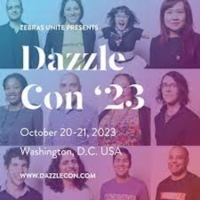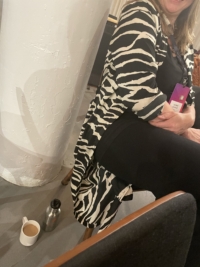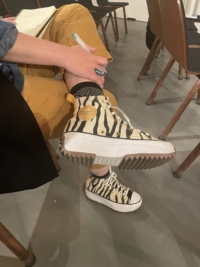
Last weekend, I attended Zebras Unite’s first DazzleCon since the pandemic began lo those many years ago.
To my surprise and delight, much of our time together was spent exploring how we Zebras could apply the principles of social evolution developed by ProSocial
whose work I first introduced here a few weeks ago. Although I was one of the few Zebras who knew much about ProSocial, I had nothing to do with getting Sage Gibbons invited to the dazzle. Indeed, it wasn’t clear to me if these two groups with seemingly different operating styles and constituencies would work well together.

I’m glad to admit that I was wrong, because this was a match made in social change heaven.
So, I want to use this post to do something I hadn’t dreamed of when I walked into the front door of the remarkable Eaton House last Thursday evening and explore the ways in which the two groups can catalyze new initiatives with each other and with the other networks I work with.
They Did Seem Very Different
It wasn’t intuitively obvious that those synergies would exist when I learned that ProSocial would be providing the bridge between the first to the second day of the Dazzle to help us shift from ideas into action.
To see why I was skeptical, consider both organizations’ tag lines..
The Zebras are an organization led by younger, entrepreneurs who want to rebuild the economy from the bottom up:
A founder-owned cooperatively led movement creating the culture, capital, and community for the next economy.
By contrast, ProSocial was inspired by David Sloan Wilson, a senior and highly respected evolutionary biologist who seemed largely to have attracted other intellectuals who share his wonderful understanding of the world but lacked either the Zebras’ edginess or their grass roots networks as reflected in its purpose statement which, unlike the Zebras’ appears at the bottom of their home page without the kind of visual splash that the Zebras are so good at.
Cooperatively evolving a world that works for all.
DazzleCon???????????
To see why I was wrong, let’s start with idea of DazzleCon itself.
As I learned when I first joined the coop and started working with its leaders in 2020, they set out “to fix what unicorns break.” Their first insight was to name themselves after a real animal rather than the mythical unicorn, something my grandchildren had figured out by the time they turned seven. They did not choose the name randomly either because, real life zebras really do gather in dazzles. Not herds. Not packs. Not pods. They dazzle in part because predatory lions have a hard time figuring out how to attack mass of animals whose striped bodies blend into each other.

My Zebra friends are in the process of creating human dazzles and, as you can see, zebra-themed fashion statements were made all over the place. Chapters in more than thirty cities on all of the world’s inhabited continents are creating new kinds of companies that serve underserved communities in ways that make sense in London or Washington or São Paulo or Phnom Penh or wherever else they are located. The one in Tokyo has helped convince the national government to adopt some Zebra principles in its new policy for reinvigorating the economy. Its own coop is experimenting with ways for Zebra aligned for profit companies to jointly develop businesses as different as a collectively own ride sharing company to one that offers pre- and post-natal care to mothers who would otherwise fall between the cracks. The latter only makes sense for a movement whose founding members refer to themselves as doulas for a new economy. Add to that the its Inclusive Capital Collective has begun raising investment funds for women and BIPOC owned startups who envision an “exit to community” rather than trying to maximize their growth toward unicorn status at which point they would sell the company and only a handful of already well-off venture capitalists and the like would make any real money.
I became an institutional investor in the coop almost as soon as I heard about the movement. Over the last three years, I’ve also gotten to know three of the founding doulas, who refer to my wife and me as “the fairy godparents we didn’t know we needed.”
How could I not love an organization that gave me my best title ever?
Seriously, I hadn’t met any of the other founders who had been in the organization since it began in 2017 and therefore looked forward to meeting them at Washington’s hip and cool Eaton House. We spent the first evening and most of the following day revisiting what the Zebras had accomplished during the pandemic years with the understanding that we would have to focus and streamline our activities in new ways if we were going to take the Dazzle to the next level which would have to involve seeking deep roots in the new economies that are emerging all over the world.
I wasn’t convinced we would get there until Sage Gibbons led a workshop to end the first day that set the stage for the very productive concluding sessions….
What Prosocial Adds
Not everything ProSocial does speaks directly to the Zebras and their aspirations. Sage chose to focus on its use of Elinor Ostrom’s eight core design principles for stewarding resources and communities held in common which I also explored here a few weeks ago.
Very few of the Zebras raised their hands (I mean their paws) when Sage asked if they had heard of Ostrom and her work. And, at the end of a long day, it wasn’t clear to me how deeply any of the eight principles sunk in when he described them and had us do an exercise that helped us see them.
Yet, when we reconvened the next morning and broke into working groups that were asked to design experiments that we Zebras could try in the upcoming year, it was clear that my group at least was surprisingly aligned with the principles—even if they had never heard them discussed in precisely those terms before.
Our group’s conclusions about dealing with people who didn’t share Zebra values are not terribly relevant here.
However, the fact that ProSocial and the Zebras share so many basic values and assumptions was obvious. Then I realized that this conclusion held even for the handful of people in the room who didn’t have much exposure to either group before attending the Dazzle. And then I realized that many of the people I worked with Sunday and Monday in the peacebuilding world shared many of those same values.
Add to that the fact that both David Sloan Wilson and most of the Zebras in the audience talk a lot about catalyzing change. Whether we are talking about a massive chemical reaction or building a massive social movement, their development is invariably aided by individuals and events who set much bigger efforts in motion and/or speed up the rate of change that is already under way. In this case, the Zebras alone will not change the world, but they understand that their initiatives can be catalytic and set in motion chains of events that will help get us there—and get us there fast.
And that led me to what I think will prove to be the most important conclusion….
What’s Next
Even before I left Eaton House, projects that brought ProSocial, Zebras, and my peacebuilding colleagues began swimming in my head. We each bring different things to the clichéd table—the big picture, the new economy, and conflict resolution skills respectively. I also could see more clearly how we could bring people who focus on climate change or personal wellness or racial justice or …. Into the picture.
So, stay tuned as we begin hanging out with each other more and exploring ideas for cooperating with each other.
The views and opinions expressed in this article are those of the author and do not necessarily reflect the official policy or position of the Alliance for Peacebuilding or its members.


